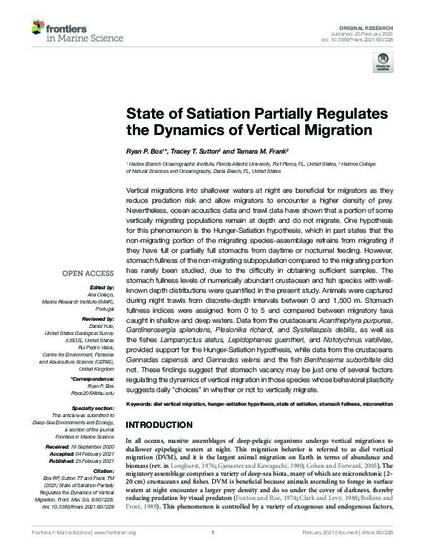
- diel vertical migration,
- hunger-satiation hypothesis,
- state of satiation,
- stomach fullness,
- micronekton
Vertical migrations into shallower waters at night are beneficial for migrators as they reduce predation risk and allow migrators to encounter a higher density of prey. Nevertheless, ocean acoustics data and trawl data have shown that a portion of some vertically migrating populations remain at depth and do not migrate. One hypothesis for this phenomenon is the Hunger-Satiation hypothesis, which in part states that the non-migrating portion of the migrating species-assemblage refrains from migrating if they have full or partially full stomachs from daytime or nocturnal feeding. However, stomach fullness of the non-migrating subpopulation compared to the migrating portion has rarely been studied, due to the difficulty in obtaining sufficient samples. The stomach fullness levels of numerically abundant crustacean and fish species with well-known depth distributions were quantified in the present study. Animals were captured during night trawls from discrete-depth intervals between 0 and 1,500 m. Stomach fullness indices were assigned from 0 to 5 and compared between migratory taxa caught in shallow and deep waters. Data from the crustaceans Acanthephyra purpurea, Gardinerosergia splendens, Plesionika richardi, and Systellaspsis debilis, as well as the fishes Lampanyctus alatus, Lepidophanes guentheri, and Notolychnus valdiviae, provided support for the Hunger-Satiation hypothesis, while data from the crustaceans Gennadas capensis and Gennadas valens and the fish Benthosema suborbitale did not. These findings suggest that stomach vacancy may be just one of several factors regulating the dynamics of vertical migration in those species whose behavioral plasticity suggests daily “choices” in whether or not to vertically migrate.
Available at: http://works.bepress.com/tracey-sutton/277/

This project was funded in part by the NOAA Office of Response and Restoration and in part by a grant from the Gulf of Mexico Research Initiative. Data are publicly available through the Gulf of Mexico Research Initiative Information and Data Cooperative (GRIIDC) at https://data.gulfresearchinitiative.org (doi: 10.7266/N7VX0DK2, 10.7266/N70P0X3T, 10.7266/N7XP7385, and 10.7266/N7902234).